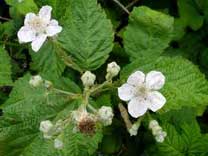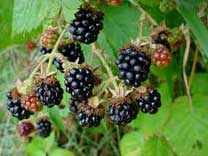

Plant Description
- Perennial shrub that forms dense thickets
- Stout stems with sharp thorns, often growing tall and arching over
- Palmate rounded leaves usually in groups of 5, toothed along the edges
- Grows in disturbed soil and prefers full sun
- White flowers in the spring, black aggregated edible berries ripen in the summer and fall
- Evergreen blackberry is a similar invasive plant but has very divided leaves, also called cut-leaf blackberry
- The native trailing blackberry has smaller leaves in groups of 3, grows lower to the ground, and has blue-green stems with fewer smaller prickles.
- Scientific Name: Rubus armeniacus
History
Himalayan blackberry and its close relative Evergreen blackberry (Rubus laciniatus) are native to Europe and were introduced to the U.S. for fruit production.
Spread
Blackberry produces a large amount of seeds that are distributed by birds and other animals. It also spreads by rhizomes and runners. Root fragments and cane cuttings can form new plants.
Ecological Threats
Blackberry can quickly create large thickets that outcompete our native plants and tree seedlings. Thick impenetrable mature stands can also reduce or restrict habitat for terrestrial wildlife. Root systems are inadequate for binding streambank soils, increasing the potential for erosion.
Control
Mechanical: Cut the plant to the ground and dig out root balls and root fragments.
Chemical: Cut in early summer and treat the resprouted canes. Treat uncut canes in the fall after fruit begins to decay. Contact our Invasive Species Coordinator by e-mail at [email protected] or call 360-992-8787, for more information on blackberry control.
Current Nationwide and Statewide Distribution
See USDA PLANTS database maps.
Himalayan blackberry is considered a Washington State Class C noxious weed and control is recommended throughout the state, though not required.
Local Watershed Distribution
Himalayan blackberry has been found in the throughout the Salmon Creek watershed, including the Salmon Creek Greenway.

